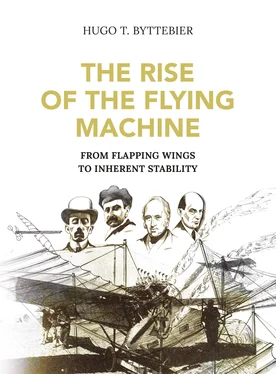There was only one quality lacking: inherent stability in the longitudinal sense. Cayley’s speculations in 1809 were not yet adequate for that purpose. Longitudinal stability, the most important of all, would now be shown shortly afterwards to an admiring aeronautical community in Paris by the second great aeronautical genius of the nineteenth century, after Sir George Cayley, a figure who would dominate the aeronautical movement during the next decade: Alphonse Pénaud.
Alphonse Pénaud
As Hureau de Villeneuve sadly remarked in 1869, most of the enthusiasm for aviation that had been aroused earlier had again been lost. But at the end of the decade it was revived with great force by a single man whose genius dominated the next few years.
A complete biography of the extraordinary and talented Alphonse Pénaud is still lacking but a special issue of the French aeronautical monthly Icare (Nº 38 of 1966) was devoted to him. Compiled by the late Charles Dollfus, at that time France’s most respected historian of aeronautics, it is the best source of information about Pénaud’s life and work.
Born on 31 May 1850, Pénaud was the son of an admiral but he was unable to follow a naval career because he was incapacitated from the age of nineteen by a hip ailment. His great mental energy then found another outlet in the furtherance of dynamic flight.
In 1869 he started his aeronautical activities by building a small-scale helicopter along the lines followed by Launoy et Bienvenu in 1784 and by Sir George Cayley in 1796. In the course of his experiments he found that rubber, when cut into fine strands and suitably twisted would provide more energy than an equal weight of rubber working under tension, as had hitherto been used.
His twisted-rubber helicopter model was shown for the first time on 20 April 1870 to de La Landelle and Hureau de Villeneuve, but Pénaud, who had become very interested in the flying exhibitions of Joseph Pline’s Papillons was gripped by the possibilities of fixed-wing flight and decided to find out if he could build a self-propelled flying aeroplane by using his twisted-rubber engine. No aeroplane type, not even Stringfellow’s steam-powered triplane of 1868, had been able to achieve flight so far.
Beginning his research by observing the fall of diverse surfaces and by studying Pline’s models, Pénaud soon designed a small-scale aeroplane which used twisted rubber as a power source. He had to apply the full keenness of his mind to make this model fly in perfect balance and find a solution to the hitherto unsolved problem of how to obtain longitudinal stability.
The model plane which was built according to his calculations received the name “Planophore” and flew for the first time in public on 18 August 1871 before an admiring group of fellow associates of the newly founded Société Française de Navigation Aérienne .
His flying model bore a decided resemblance to a modern aeroplane as it had a monoplane wing in front and a small fixed tail at the rear. It weighed only 16 grams (0.56 oz) and with a wing that had a surface of 490 square centimetres (0.53 sq ft) the wing loading amounted to merely 0.0714 lbs/sq ft.
It was driven by a single propeller at the rear and, in order to counteract the torque of the revolving propeller, one side of the wing was made longer than the other.
After applying the necessary energy to his rubber strands by giving the propeller 240 turns, the little aeroplane flew for 11 to 13 seconds, covering between 40 and 60 metres (130 to 200 ft.). Because of the low wing loading it flew very slowly at 3.6 m/s (about 13 kph or 8 mph) and yet showed a remarkable steadiness in flight.
Pénaud had discovered the secret of inherent longitudinal stability. He described his discoveries and the calculations related to them in a remarkable article published in L’Aéronaute of January 1872 under the simple title “Aéroplane Automoteur” and with the revealing subtitle “Stabilité Automatique”.
As he stated in the article, “Luckily, after a few investigations, I imagined a very simple device, which achieved the desired goal.” This simple device was a small fixed horizontal tail, inclined downwards with reference to the main lifting wing and at a certain distance to the rear. Just as Cayley had indicated the way to obtain lateral stability by giving a small dihedral to the wings so that they looked like a flattened V when seen from the front, Pénaud now proposed to use the same means in a longitudinal direction because the angle formed by the wing and the stabilizing tail also formed a very flat V.

Because this tail surface was restraining, it produced a certain amount of drag and hence power was wasted by this kind of construction, but it is the toll that has to be paid in return for safety in the air.
The propeller of the “Planophore” was at first situated at the rear, but in 1875 he also flew a planophore with a tractor propeller at the front. The little model plane was so stable that it flew without a vertical fin, but it could only fly in a windless atmosphere, preferably indoors, where most of Pénaud’s exhibitions were held.
His article ended as follows: “Whatever the results, my planophore proves the possibility of the aeroplane system, the possibility of a stable equilibrium surrounded by air and promises a considerable speed for great machines.”
In 1871 it may be said that all the elements of the modern aeroplane form were in existence, excepting again, the engine. Inspired by Pénaud’s research, a new branch of the existing aeronautical society was formed as the Société Française de Navigation Aérienne . Hureau de Villeneuve was appointed its president and Pénaud was the archivist and librarian. He thus had access to all the publications of the society and he studied every one of them.
In the January 1873 issue of L’Aéronaute , he published a theory of the aeroplane entitled “Laws of Gliding through the Air” in which he made reference to Newton, to Navier’s error, to Wenham and to Cayley, whose articles, published in France in 1853, he had also read.
Cayley’s writings aroused his interest and he began to search through British technical literature of the early nineteenth century, eventually coming across Cayley’s triple paper “On Aerial Navigation” in Nicholson’s Journal in 1809 and 1810, referred to previously.
Pénaud thus encountered a mind equal to his own and was astounded by the clarity of Cayley’s essay: “These writings,” wrote Pénaud, “which have lain dormant and forgotten on the dusty shelves of old libraries, are among the most important which exist relating to aerial navigation.”
“Nobody has understood the impact of this mind, nobody has encouraged or helped him, or was stimulated by these life-giving ideas. The tree died before it bore fruit and Cayley’s very existence was unknown in France. It is our duty to raise his name from oblivion.” And he duly did so, as Cayley’s triple paper was translated into French and published in L’Aéronaute during 1877.

The Study of Bird Flight
Meanwhile, Professor Etienne Jules Marey had made profound studies of the flight of birds. After it had been discovered that by putting a kite in motion it could fly like a bird, Marey’s observations showed that a bird is also like a kite, meaning that it follows the same aerodynamic laws as the fixed-wing flying machine.
Читать дальше














